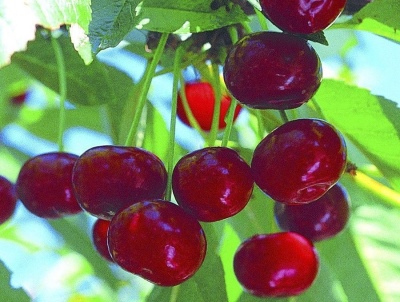
- Authors: E.P. Syubarova, P.M. Sulimova, M.I. Vyshinskaya (Belarusian Research Institute of Horticulture)
- Appeared when crossing: Griot Ostheim x Denisena yellow
- Year of approval: 2002
- Barrel type: wood
- Growth type: medium-sized
- Crown: round, medium density
- Flowers: white
- Fruit size: medium
- Fruit shape: rounded
- Fruit color: dark red
Cherry Zhivitsa belongs to early ripening hybrids. The culture grows well in regions with cool climates. The variety is absolutely unpretentious in care, gives a good harvest and pleases with very tasty fruits.
Breeding history
The variety is a hybrid of cherry and cherry, belonging to the group of dukes, but it is a separate species. The plant was created about 20 years ago by Belarusian breeders. The basis was taken from the German yellow Denissen cherry and the Spanish Griot Ostheim cherry. Zhivitsa was included in the State Register in 2002.
Description of the variety
The tree grows not very tall, reaching a height of 3 m. The trunk grows almost even, and branches with slightly sagging tips stretch upward. The location of the shoots is infrequent. The tree forms a neat, rounded crown that grows slowly. The variety is not characterized by excessive thickening, therefore, sanitary pruning is required.
Medium-sized leaves are elongated and rich dark green color. Fruit buds are formed on the shoots of the current year. Small white flowers, collected in inflorescences of 3 pieces. The virtues of culture:
- excellent fruit taste;
- early maturity;
- frost resistance;
- high immunity.
Flaw:
- you need to plant several varieties of pollinators.
Fruit characteristics
The variety is characterized by a small mass of fruits: 3-4 g. Their shape is neat and round. The color is rich dark red. The stone is small, well separated from the pulp. The skin is thin and relatively fragile.
Taste qualities
Despite the fact that the sugar content in the fruit is small (about 9%), the taste is sweet with a pleasant sourness. The very juicy pulp is of medium density. On a five-point tasting scale, cherries are rated at 4.8 points. You can eat the fruits both fresh and processed.
Ripening and fruiting
The tree fully begins to bear fruit in the 4th year of development. Refers to early ripening varieties. Delicious cherries can be tasted at the end of June.

Yield
With proper agricultural technology, 10 tons of crops can be harvested from one hectare. On average, one tree is capable of producing 12-15 kg of fruit.
Self-fertility and the need for pollinators
Unfortunately, hybrid cherry varieties need cross-pollination to produce good yields. As experienced gardeners note, 3-4 trees of early fruiting should be planted on the site. The best pollinating varieties are Griot, Denisen. It is permissible to plant Seedling No. 1, Vianok, Novodvorskaya. It should be noted that Zhivitsa is not pollinated by plants of its own species or closely related varieties.
Landing
Zhivitsa does not have any special requirements for planting cherry. The exception is the time and layout of the bushes.According to gardeners, the best time for planting is spring. In the case of planting a plant in the autumn, it will be necessary to cover a young seedling for the winter with agrofibre.
The variety grows well in sunny places, protected from drafts. Prefers to grow on fertile soils (black soil, light loam, chestnut, sandy loam). The soil should be loose and structural, breathable, capable of providing sufficient oxygen access to the cherry roots.
Gardeners recommend planting trees at a distance of 5 m from each other and 3 m between rows. They choose 1–2-year-old specimens without signs of disease, dry shoots and damage. A planting pit with a diameter of 60x60 cm and a depth of up to 80 cm is prepared several weeks before planting. At the bottom of the hole I put several buckets of compost or humus with a slide on which the seedling is placed. Sprinkle the hole with soil, ram it and water it abundantly.


Growing and care
Tree care is simple and consists in timely watering, enrichment of poor soil with mineral and organic fertilizers and regular pruning. Irrigation is carried out several times a week, since the roots of the tree are branched and superficial. If there is enough rain, no watering is necessary. If dry weather is established, watering should be increased, otherwise the tree will begin to shed its leaves and weaken.
Top dressing is applied several times a year. In the spring, the plant requires nitrogen-containing fertilizers. In late autumn, the tree is fed with phosphorus and potassium.
Pruning is carried out as needed. The main thing is to form the crown on time. The farther north the growing region is, the lower the height of the tree should be. With winters with frosts up to 30 °, the plant is formed according to the bush type.


Disease and pest resistance
The variety tolerates most of the diseases inherent in the culture. However, prophylactic treatment for coccomycosis and moniliosis should be carried out. In spring and autumn, the soil must be dug up, dry grass and leaves are removed. In March, before the start of sap flow, the trunk and branches are sprayed with copper sulfate.
































































